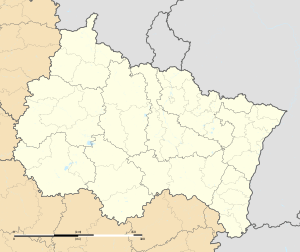Landres
Landres is a commune in the Meurthe-et-Moselle department in north-eastern France.
Landres | |
|---|---|
 Place de l'Église. | |
 Coat of arms | |
Location of Landres 
| |
 Landres  Landres | |
| Coordinates: 49°19′20″N 5°48′21″E | |
| Country | France |
| Region | Grand Est |
| Department | Meurthe-et-Moselle |
| Arrondissement | Briey |
| Canton | Pays de Briey |
| Intercommunality | Communauté de communes du Bassin de Landres |
| Government | |
| • Mayor (2008–2014) | Marc Ceccato |
| Area 1 | 8.04 km2 (3.10 sq mi) |
| Population (2017-01-01)[1] | 974 |
| • Density | 120/km2 (310/sq mi) |
| Time zone | UTC+01:00 (CET) |
| • Summer (DST) | UTC+02:00 (CEST) |
| INSEE/Postal code | 54295 /54970 |
| Elevation | 280–346 m (919–1,135 ft) (avg. 305 m or 1,001 ft) |
| 1 French Land Register data, which excludes lakes, ponds, glaciers > 1 km2 (0.386 sq mi or 247 acres) and river estuaries. | |
This region of Europe has been occupied by humans since prehistoric times. Archaeological finds in the local area date back to the Mesolithic era. The present settlement and its name date back to at least the medieval period. Historically, there was a chateau, and a noble family, associated with Landres. While it was not in the part of the Lorraine annexed by Germany after the Franco-Prussian War, from 1871 to 1918 the location of the village was fairly close to the border with the German Empire. The community was occupied by Germany during the First World War, and was within the German (Northern) zone of military occupation during the Second World War. According to French census data, Landres' population peaked in the decade of the 1900s, and began a decline in the early 1910s, which was sharply accelerated by the events of World War I; during which the village was damaged by shelling & abandoned by many or most of its French inhabitants. After that war, population numbers recovered somewhat; but even during the post World War II population boom, the numbers never returned to their levels from first decade of the Twentieth Century.
.jpg) A ruined street in Landres, 1916; postcard drawing by a German soldier. As can be seen in the lede photograph, the church appears to be the only surviving structure from this scene.
A ruined street in Landres, 1916; postcard drawing by a German soldier. As can be seen in the lede photograph, the church appears to be the only surviving structure from this scene. Another view of the village church
Another view of the village church La Mine de Micheville in Landres, circa 1930
La Mine de Micheville in Landres, circa 1930 Map of the commune
Map of the commune
See also
![]()
References
Includes material from the French-language version of this article
- "Populations légales 2017". INSEE. Retrieved 6 January 2020.